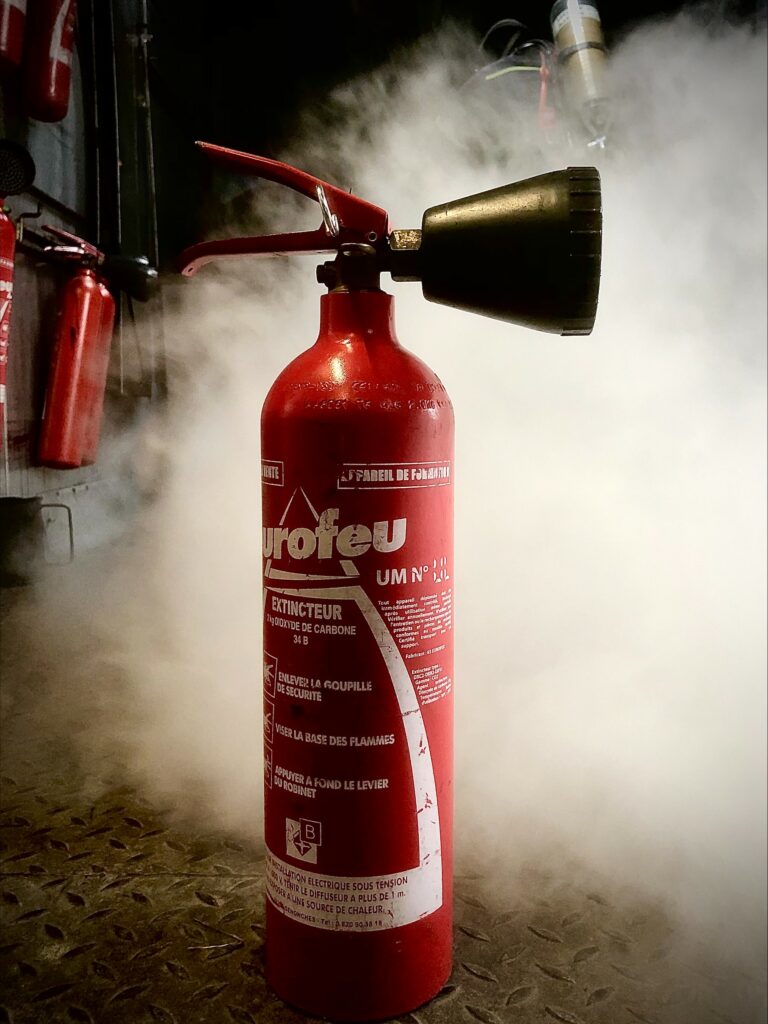What is fire extinguisher training?
Training in the use of fire extinguishers is a crucial step towards improving safety in the workplace. It is aimed at professionals, and is designed to teach them the correct handling of an extinguisher in the event of a fire. In general, this training covers both theoretical and practical aspects, from regulatory requirements to hands-on exercises. Although its mandatory nature may vary, it is strongly recommended to ensure an adequate response in the event of a fire breaking out.
Understanding fire extinguisher training
To master the use of extinguishers, it's essential to understand how they work and the types of fire they can extinguish. Each extinguisher model is designed for specific classes of fire:
- Class A for solid materials such as paper
- Class B for flammable liquids
- Class C for gases
Choosing the right extinguisher for the right situation is crucial. A water extinguisher, for example, is not suitable for an electrical fire. Training often includes practical exercises on real fires, enabling you to train under realistic conditions.
Participants also learn how to spot potential hazards and use the fire extinguisher safely to avoid causing injury. A thorough knowledge of evacuation procedures completes the training to ensure an effective response in the event of fire.
Training objectives
The objectives of fire extinguisher training are to guarantee effective control of the equipment and ensure worker safety. Here are the main objectives:
-
Understand the fundamentals of fire: learn the conditions under which a fire starts and spreads, so you can intervene quickly.
-
Know how to use the different types of extinguisher depending on the type of fire: water extinguishers, for example, should not be used on electrical fires.
-
Be able to react to an outbreak of fire: Identify the risks, isolate the area and quickly alert emergency services.
-
Putting safety instructions into practice: Participating in live fire exercises to reinforce learning and avoid clumsy gestures.
These objectives enable us to develop the reactivity essential for limiting damage in the event of fire.
Target audience
Training for companies
For companies, fire extinguisher training is essential to ensure safety in the workplace. Employers must ensure that all employees are familiar with the extinguishing techniques appropriate to each situation. This training generally includes theoretical and practical sessions, enabling workers to familiarize themselves with the different types of extinguisher and emergency situations.
Benefits include:
- Risk reduction: Well-trained personnel can intervene quickly, reducing potential damage.
- Legal compliance: Comply with the requirements of the French Labor Code, in particular article R4227-28.
- Improved reflexes: Practical exercises on live fire reinforce the ability to act effectively.
By investing in this training, companies protect not only their employees, but also their property. A concrete example: in the event of an incipient fire, a trained employee can use a CO2 extinguisher to prevent the fire spreading.
Fire extinguisher training regulations
Training obligations under the French Labor Code
According to the French Labor Code, fire extinguisher training is mandatory to ensure safety in the workplace. All employees must receive practical and appropriate fire safety training, in accordance with article R4227-28. This training must include :
- Knowledge of fire extinguisher types and their use
- Recognizing different alarm signals
- Implementing the maneuvers required to evacuate the premises safely
Employers must also ensure that fire extinguishers are in sufficient number and working properly, as stipulated in article R4227-29. Where specific risks are involved, suitable extinguishers must be installed to ensure optimum protection. These measures are essential to prevent damage in the event of fire and ensure the safety of workers.
Validity of a fire extinguisher training course
To be effective, fire extinguisher training must be renewed regularly. The recommended frequency varies according to the company's needs and the specific risks to which it is exposed. In general, annual refresher training is recommended to keep skills up to date. Some companies opt for a two-year interval.
The period of validity can also be influenced by technological developments or changes in the equipment used. It is therefore essential to adjust the frequency of training courses in line with new standards or modifications to installations.
In case of doubt, it's best to follow the recommendations of specialized organizations or consult fire safety experts to determine the best approach for your professional context.
Refresher courses and fire extinguisher training checks
Regular refresher training is essential to ensure the effectiveness of extinguisher training courses. Refresher sessions enable participants to refresh their knowledge and familiarize themselves with new practices. It is often recommended to organize these sessions every year. However, some companies opt for a three-year interval to adapt training to their specific needs.
Fire extinguisher training must be rigorously controlled. Trainers must ensure that each participant has mastered the safety gestures. It is crucial to check that the extinguishers used during training are well maintained and comply with current standards. Fire extinguishers must be checked every year by a professional.
To reinforce learning, practical exercises, such as extinguishing simulated fires, are integrated into training courses. These give participants the opportunity to practice in real-life conditions, which considerably improves their reactivity in the event of a fire.
Fire extinguisher training content
Learn how to use a portable extinguisher
Handling a portable extinguisher requires an understanding of precise gestures to ensure its effectiveness. Here are some key steps to remember:
- Check the label: make sure the extinguisher is suitable for the type of fire.
- Remove the safety pin to release the release mechanism.
- Hold the extinguisher firmly, aiming at the base of the flames.
- Press the handle to release the extinguishing agent in a sweeping motion.
When using, it is important to position yourself with your back to the wind to minimize exposure to fumes. It is also crucial to maintain an appropriate safety distance to avoid any risk of burns. Practising these actions in a controlled environment, such as during simulation exercises, promotes faster, more effective intervention in the event of a real fire.
Maintenance and use of fire extinguishers
Regular maintenance of fire extinguishers ensures their smooth operation and prevents failure in the event of a fire. This includes annual checks by a certified professional. Fire extinguishers must be easily accessible and clearly marked throughout the company.
Good maintenance also means :
- Visual inspection for damage
- Checking pressure and weight
- Complete overhaul every five years
To use an extinguisher effectively, it's essential to know the different classes of fire and choose the right model. For example, a water spray extinguisher is suitable for Class A fires, while a CO2 extinguisher is ideal for electrical fires. If necessary, training in these aspects can enhance safety in the workplace.
Fire management and use of extinguishers
To manage a fire effectively, it's essential to know the key steps in using extinguishers. First and foremost, identify the type of fire to choose the right extinguisher. Approach slowly, keeping a safe distance, and direct the jet towards the base of the flames.
When using, make sure you keep away from the fumes to avoid inhaling toxic substances. If you have any doubts about your ability to control the fire, evacuate the area and alert the emergency services.
A few practical tips for a successful intervention:
- Rapid assessment of the situation to determine the best approach
- Methodical use of the extinguisher, sweeping the area concerned
- Regular checks on fire extinguishers to ensure they are working properly
These practices ensure a rapid and effective response to any outbreak of fire, protecting people and property.

Read our other articles here! :


